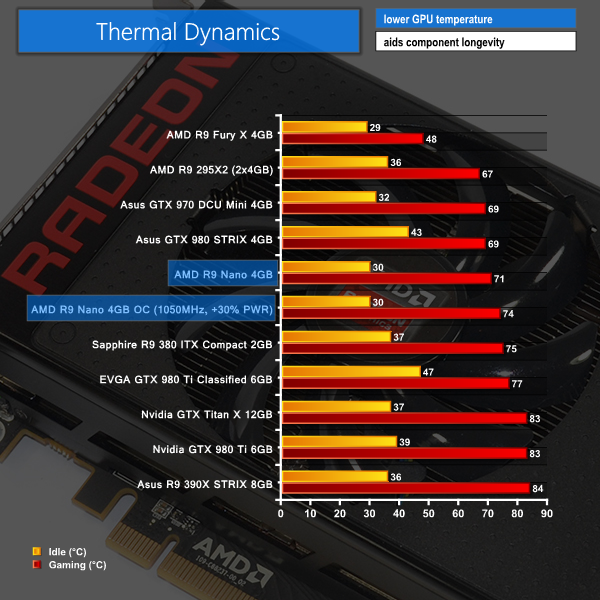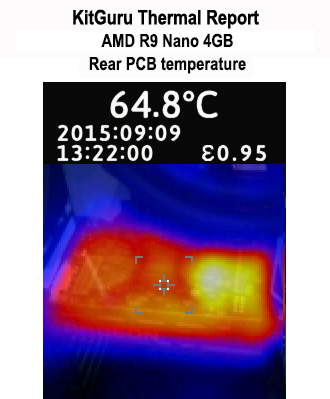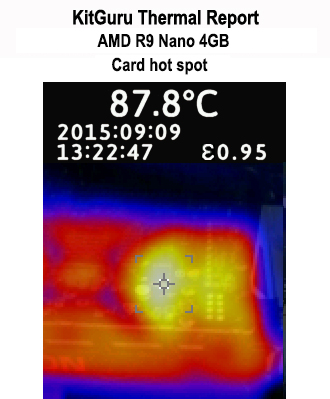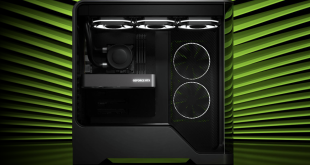The tests were performed in a controlled room with temperatures maintained at a constant 25°C – a comfortable summer environment for the majority of people reading this. Idle temperatures were measured after sitting at the desktop for 15 minutes. Gaming measurements were acquired by repeating the GTA V benchmark for 15 minutes and taking the stabilised reading. All fan settings were left on automatic.

AMD's temperature target is 75°C and that's pretty much where the card will reach after a long enough session of gaming. The fan speed ramps up to a user-definable maximum (65% by default) in order to hit the target GPU temperature and stay well away from the 85°C throttling point.
The rear PCB hits a temperature level in the 60s very quickly after load is applied. The card's hot-spot is directly behind the VRM components, and temperatures climbing towards the high-80s quickly after load being applied are borderline concerning.
I say ‘borderline' because the VRM components themselves are perfectly capable of running at temperatures that most people would perceive as worrying (100°C plus is fine for certain MOSFETs and inductors). But that heat spreads along the PCB and soon reaches its way to the GPU area, forcing temperatures higher. There's also the concern of a fan cable or some other connector contacting the PCB inside a SFF system. This could cause the cable plastic to melt, and that's a bigger headache.
I would have liked to see AMD make use of a backplate on the card. Not only would this help to effectively (and easily) distribute heat away from the MOSFET area, it would also act as a protection barrier for cables that are touching the card. I'm not saying that these temperature levels should have you worried about melting cables, but if the plastic lead from one's cheap fan is going to melt, I'd rather it do so on a metal backplate than the card's expensive PCB.
 KitGuru KitGuru.net – Tech News | Hardware News | Hardware Reviews | IOS | Mobile | Gaming | Graphics Cards
KitGuru KitGuru.net – Tech News | Hardware News | Hardware Reviews | IOS | Mobile | Gaming | Graphics Cards





Price!! AMD… I know it’s unique but you had a good opportunity to fight NVIDIA but you priced yourself too high (again).
And with their yield issues it will be priced even higher at retailers lol.
Who are you kidding?
I can’t see how they can charge the same as a Fury X and the Fury X has the added cost of watercooling.
Don’t matter on price, Gaming enthusiast’s will buy it just because of the size and performance it give’s, If people are willing to spend like 1500 for a titan X, I’m sure people will pay 1/3 of the price for the nano.
Can you cram Fury x into SFF case?
^ This, it delivers very well for the size/form factor in spades. But if anyone has the space/non ITX case to house longer cards the Nano isn’t for them, people just need to realize this and move on.
yes. Read a review somewhere (Hexus?) where they mentioned you could cram a Fury X into some mITX cases 🙂
Most mITX cases are long, to incorporate a full sized GFX card, you can for example get a Strix 980 into a Fractal Node 304. It’s only when you get down to stuff like the Coolermaster Elite 110 that an mITX card becomes necessary.
For £515 you can buy a 980Ti, unless you really needed a smaller card why would you purchase this ?
Indeed. Most of the people complaining about the niche this card lives in wouldn’t be buying one anyway, they’re just more interested in complaining about it.
Most of the complaining is from nvidia fanboys, trolls or paid shills. There is no way a sane consumer can be totally blind to the value proposition this card gives in ultra SFF compared to useless value the titan X gives when it is so overpriced for any form factor.
Of course there are some legitimate voices of dissatisfaction among those who really wanted to buy this card thinking it will be a more cut down version of Fiji chip and could be had for like 400-450 USD, those people have legit reasons to be slightly miffed but given the performance this thing shows they will quickly realize this card isn’t for them, the $549 R9 Fury is.
I would buy it with no hessitation, and I’m a full tower user.